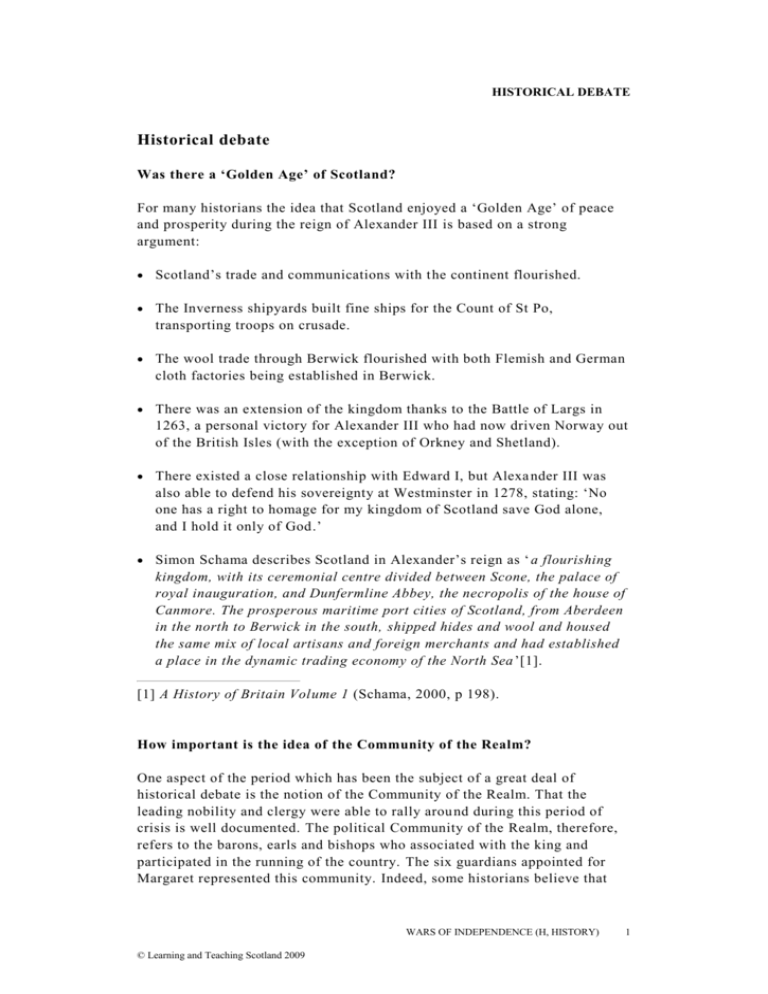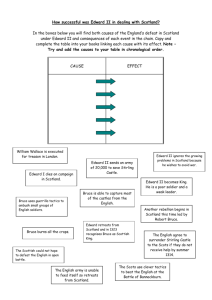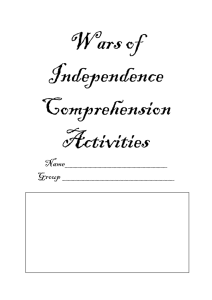The succession problem: historical debate
advertisement

HISTORICAL DEBATE Historical debate Was there a ‘Golden Age’ of Scotland? For many historians the idea that Scotland enjoyed a ‘Golden Age’ of peace and prosperity during the reign of Alexander III is based on a strong argument: Scotland’s trade and communications with t he continent flourished. The Inverness shipyards built fine ships for the Count of St Po, transporting troops on crusade. The wool trade through Berwick flourished with both Flemish and German cloth factories being established in Berwick. There was an extension of the kingdom thanks to the Battle of Largs in 1263, a personal victory for Alexander III who had now driven Norway out of the British Isles (with the exception of Orkney and Shetland). There existed a close relationship with Edward I, but Alexa nder III was also able to defend his sovereignty at Westminster in 1278, stating: ‘No one has a right to homage for my kingdom of Scotland save God alone, and I hold it only of God.’ Simon Schama describes Scotland in Alexander’s reign as ‘ a flourishing kingdom, with its ceremonial centre divided between Scone, the palace of royal inauguration, and Dunfermline Abbey, the necropolis of the house of Canmore. The prosperous maritime port cities of Scotland, from Aberdeen in the north to Berwick in the south, shipped hides and wool and housed the same mix of local artisans and foreign merchants and had established a place in the dynamic trading economy of the North Sea ’[1]. [1] A History of Britain Volume 1 (Schama, 2000, p 198). How important is the idea of the Community of the Realm? One aspect of the period which has been the subject of a great deal of historical debate is the notion of the Community of the Realm. That the leading nobility and clergy were able to rally arou nd during this period of crisis is well documented. The political Community of the Realm, therefore, refers to the barons, earls and bishops who associated with the king and participated in the running of the country. The six guardians appointed for Margaret represented this community. Indeed, some historians believe that WARS OF INDEPENDENCE (H, HISTORY) © Learning and Teaching Scotland 2009 1 HISTORICAL DEBATE the six guardians were deliberately chosen to represent the different geographical regions of Scotland, with two earls, two lords/barons and two bishops to represent the different spheres of power. Robert Bruce and John Balliol were not chosen to be guardians, and that could say something about the tension at the time. Barrow suggests that the membership of the guardians was deliberately designed to represent these two factions. On the other hand, other historians argue that the Bruce faction felt excluded during this period. That the guardians managed to work together so effectively suggests that in 1286, with the threat of civil war hanging over them, they were able to come together for what was deemed the good of the kingdom. That Bishops Fraser and Wishart had a strong influence in this cannot be denied. The two statesmanlike clerics probably steered the magnates of the kingdom around to their way of thinking. Nevertheless, the guardians were remarkably practical in their dealings with their own countrymen, as well as Edward I. Again, with the backing of the bishops, the guardians were able to agree at the Parliament of Scone to accept Margaret as queen. Even Robert Bruce accepted ( although apparently with poor grace). It is a notable achievement for them to have held the kingdom together in the name of a three -year-old, to enforce the laws and negotiate with a foreign power. Professor Barrow strongly believes in the existence of this Community of the Realm of Scotland. He states: ‘Of course there was such a community, even when a king was on the throne, but in normal times, with an adult and vigorous rulers, the community would fade into the background .’[2] Fiona Watson agrees, stating that ‘Despite the reputation usually given to them, the Scottish nobility, while by no means entirely united (an d what group of politicians are!), managed to maintain control of the situation ’.[3] It should, however, be noted that this concept of the Community of the Realm does not seem to have emerged before 1286 and meant different things at different times to different people. It is a different concept from modern -day ones of nationhood and nationalism, but is representativ e of perhaps the birth of these ideas. [2] Robert Bruce (Barrow, 1988, p 16). [3] In Search of Scotland (ed. Gordon Menzies, 2001, p 68). 2 WARS OF INDEPENDENCE (H, HISTORY) © Learning and Teaching Scotland 2009 HISTORICAL DEBATE Why was the Treaty of Birgham so important to the Scots? In essence, the Guardians of Scotland may have been happy enough with the marriage proposal between young Edward and Margaret, but they were at least a little anxious about Edward I. The marriage would have removed the threat of civil war. However, the guardians felt they needed to be involved in drafting the treaty, rather than be sidelined by the negotiations between Margaret’s father, the King of Norway, and Edward I. Thus they were keen to see some safeguards installed in the treaty that would ensure the long -term survival of their ancient customs and rights. Parliament would not be held outside Scotland, nor would they be called to pay feudal dues to Edward I. It was therefore was important to maintain the independence of Scotland. Some historians have argued that Edward’s guarantee of Scottish independence and the lack of mention of overlordship within the Treaty of Birgham demonstrate his good intentions towards Scotland in 1290. However, it is important to note that althought the issue of overlordship is not explicitly mentioned, Edward was careful to reserve his rights despite the various guarantees offered to the Scots. He may not, at this stage have been interested in overlordship, but he did not give up his right to return to this issue at a later date. Some others point out that Edward wanted, and indeed did, appoint his own representative in Scotland. Bishop Bek of Durham was sent north to be Edward’s lieutenant and the caretaker of the kingdom on behalf of the betrothed couple, while at the same time Edward absorbed t he Isle of Man into his territory. However, it is a matter of debate as to whether there was anything sinister in Edward’s actions at this stage. What were Edward’s intentions towards Scotland? Edward’s intentions towards the Scots have led to much historical debate. Historians are somewhat contradictory about what Edward’s aspirations were at any specific time. It has been said that Edward was initially ambivalent about the fate of Scotland; he was after all in France when Alexander III died. His treatment of the Scots at Birgham would lend some credence to this argument. The situation with France was clearly a concern to Edward at this point. From this, some historians have put the case that Edward pursued the issue of overlordship perhaps in order to pr event the Scots from taking France’s side against the English. However, others, such as Fiona Watson, point out that England did not actually go to war with France until 1295. We do know that Edward had written to all English monasteries asking them to search their records and libraries for any written reference or justification for England’s overlordship to Scotland, prior to the meeting at Norham. He also had his fleet on standby ready to blockade Scottish ports and was summoning levies from the northern counties to form an army. It was probably clear to the guardians that his attitudes towards Scotland had WARS OF INDEPENDENCE (H, HISTORY) © Learning and Teaching Scotland 2009 3 HISTORICAL DEBATE changed with the death of the Maid of Norway, and many historians agree that this tragic incident altered Edward’s intentions to his northern border . Perhaps the success of absorbing Wales into England’s sphere of influence created the belief that the same could be done with Scotland and here was the perfect opportunity. Most historians agree that Edward, who was on friendly terms with Alexander III, saw this as his opportunity to take advantage of Scotland during its period of weakness. He was also the great-uncle of the Maid of Norway and so could expect to wield influence over her and, thereby, over Scotland. On her death, his method of achieving influence was also forced to change. Certainly, no King of Scots had previously been treated in such a way as Edward would treat King John. Who had the rightful claim to Scotland? The process of deciding on the next king following the death of the Maid of Norway was long and drawn-out, lasting over 15 months. Edward, now that overlordship was assured, wanted to see justice served and took the advice of experts to ensure that the correct precedent was set (perhaps with an eye to his own inheritance). The first question which had to be addressed was whether Scotland should remain as one kingdom, or whether it should be split between the leading claimants, with one taking the title as well as his share of land. John of Hastings argued for this, but the court d ecided that Scotland would remain intact. Then there was the question of who had the best claim. With Alexander III’s line dead the court was forced to look at the earlier generation of the royal family, the offspring of William the Lion and his younger brother David, Earl of Huntingdon. Both Bruce and Balliol were genuine descendants of David, but crucially Bruce was the son of the middle daughter of Earl David, while Balliol, though a grandson, was descendant from the eldest daughter of Earl David. The law of primogeniture – the legal process where inheritance would pass down the eldest line – was becoming more accepted in Scotland but was by no means the guaranteed way in which the court would rule. Robert Bruce unsuccessfully argued that primogeniture had no meaning in this case because a kingdom was special and therefore ordinary customs did not apply. The court decided this was not true and his application was rejected. In desperation he then joined Hastings in his attempt to get the kingdom split into three and shared equally, but again he was unsuccessful. Medieval chroniclers writing after the Wars of Independence took the view that Balliol was chosen because he was a weak man who could be pushed around by Edward, in contrast to the stonger charact er of Robert Bruce. However, their writings are almost certainly influenced by the context within 4 WARS OF INDEPENDENCE (H, HISTORY) © Learning and Teaching Scotland 2009 HISTORICAL DEBATE which they were working, given that the kings during this period were descendants of Robert the Bruce. The views offered in these chronicles can be taken as propaganda for the Bruce family. Revisionist historians, therefore, tend to disagree with the opinion of the chroniclers. There is no evidence that Balliol was particularly weak; any king would have found it difficult to work in the conditions he struggle d under. Added to this is the fact that he had the better claim as primogeniture was becoming established as a custom in Scotland. The choice was nothing to do with character; it had everything to do with legitimacy. Moreover, Robert Bruce the competitor and his son the Earl of Carrick were the first to swear an oath of fealty to Edward, and often acted subserviently to the English king in the hope of securing his favour and forwarding their cause. WARS OF INDEPENDENCE (H, HISTORY) © Learning and Teaching Scotland 2009 5






